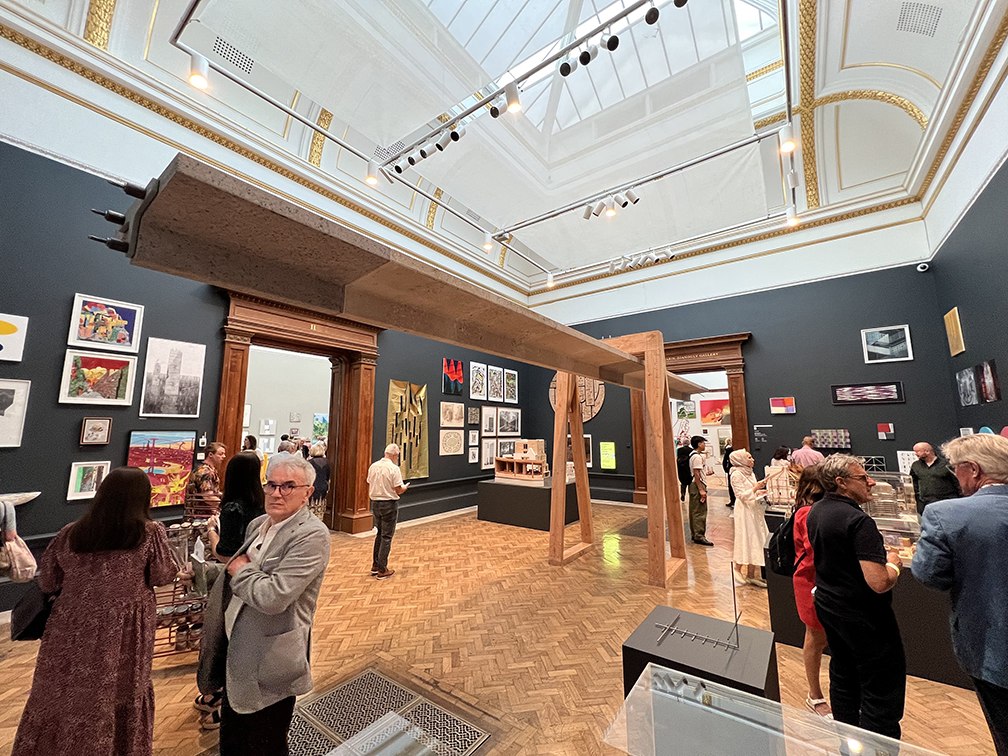Portland stone company Albion Stone has worked with The Stonemasonry Company in Ketton, Rutland, and London engineers Webb Yates to produce an 11m long beam of stone made mostly of Portland limestone and some reclaimed granite that is now hanging from a wooden frame in The Royal Academy of Arts Summer Exhibition at Burlington House, Piccadilly, London.
Michael Poultney, MD of Albion, told Natural Stone Specialist: “I honestly never thought I would live to see the day when they were lifting up an 11m beam of Portland stone.”
The Portland stone has pieces of granite at either end and in the middle and the whole beam is threaded with steel that is post tensioned to hold it all together. It was assembled in the Royal Acadamey of Arts because it would have been too big in its assembled state to get into the building.
There are plans to display it at the Oxo Building in London when the Summer Exhibition comes to an end on 21 August. After that, it is hoped to show it in New York. It can be moved relatively simply by unthreading the steel tensioners and taking it apart.
The Stonemasonry Company, which assembled and post-tensioned the beam for Webb Yates, has worked with the engineers on a number of spectacular post-tensioned stone staircases, and on Amin Taha’s 15 Clerkenwell Close development in Islington, London.
At 15 Clerkenwell Close, architect Amin Taha designed an exoskeleton of French limestone. He said at a Stone Federation webinar called The Case for Stone in February that using stone and wood could transform construction from a net contributor of carbon to the atmosphere to an industry that is helping to remove it.
He admitted: “Now, that’s controversial to say because you can only define it as carbon negative if you passport a material, which basically means if you identify it and then during [the building’s] demolition it’s identified and re-used and the timber is not sent to landfill to rot or burnt for fuel. Combine that with stone, that’s your answer. The construction industry, instead of being a 38% contributor to atmospheric carbon, if we all clicked our fingers and went to timber and stone we’d be a carbon sequestration industry – we would be helping to take the carbon dioxide out the atmosphere.”
It might not be quite that simple because the 38% contribution to CO2 emissions includes buildings in use, not just in construction, but nevertheless, it would make a contribution towards net zero compared with using steel, glass and concrete.
And that was the point the creation of the 11m beam of Portland limestone and granite was supposed to demonstrate at The Royal Academy.
The Portland stone used would otherwise have been crushed, because it was stone that had been rejected for other projects by architects who wanted a uniform look to their stone. Using the language of the fashioned industry, where ‘previously loved’ clothes are sold on, Michael says the beam used some of his ‘unloved’ stone. The granite was salvaged from a condemned postmodern building being demolished in London Docklands.
Steve Webb of Webb Yates said at The Case for Stone webinar: “The thing about quarrying in the UK, we want metre by metre dimension stone with the strength of 100 Newtons. I don’t care what colour it is or where it comes from or whether it’s a lovely Kentish ragstone or a Cornish whatever-you-call it. I don’t care; just need the strength, the size and the price – €500 a cube, or something like that.”
Whether the stone in the 11m beam lives up to those expectations, especially the price, goes unrecorded, although Michel Poultney says the stone was more competitively priced than normal. Even so, because everything in the Royal Academy of Arts Summer Exhibition has to be for sale, the beam has been given a price tag of £30,000, if anyone is interested in buying it.
Albion Stone has also supplied some ‘unloved’ stone to The Stonemasonry Company for a post-tensioned colonnade in British stone at the company’s premises. It is intended to be a demonstration of what tensioning can achieve beyond staircases.
Michael Poultney says he finds the use of his ‘unloved’ stone interesting. “Is it time to start thinking about how we are using stone, as Steve Webb said,” he asks? “We’re looking at getting off our backsides and seeing if there’s some mileage in it.
“A lot of architects come here to Albion to select their stone and we end up scrapping a lot of perfectly good material that they reject. This could use it. I think people are changing their minds about the stone they are prepared to use; they are buying into the carbon reduction idea. In the next couple of years I think it’s really going to start making a difference.”

